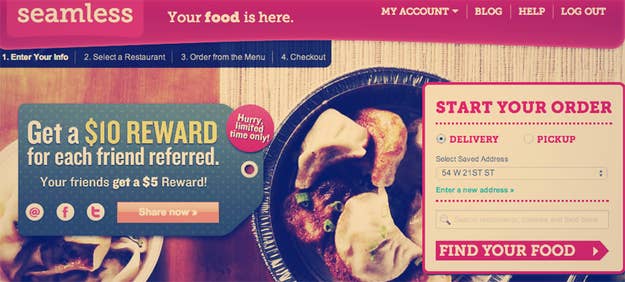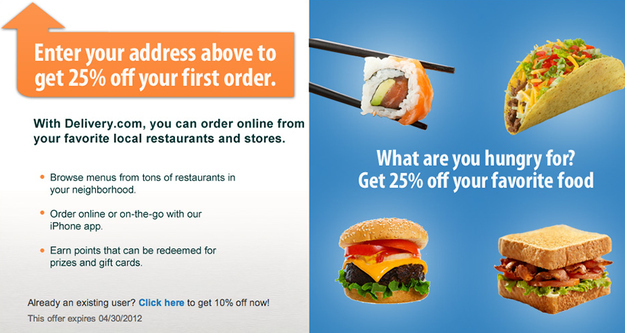
New York City is teeming with a permanent underclass of bicycling immigrants freighting styrofoam containers of hot calories from the city’s closet-size take-out joints to its closet-size apartments. It’s a beautiful network of junk-food trafficking. But can a man subsist on delivery food alone? Of course he can. I did. And I’m still alive, sort of.
I didn’t intend to embark on this Morgan Spurlockian experiment. But in the past half year, I’ve lived for months on end eating nothing but food ordered from online delivery sites like Seamless, GrubHub, and Delivery.com. I did it because I got the food for free, more or less. Then I just kept doing it.
Restaurant delivery websites are plentiful on the Internet, and it’s easy to see why — it’s an obvious and attractively simple business model. Take-out joints are unlikely to have their own website, much less a well-coded, up-to-date portal allowing customers to order online. Sites like Seamless can pool these restaurants together, digitize their menus, and take a commission on each order when it sends them to the guy working the fryer.
Seamless, which recently changed its name from SeamlessWeb, is practically Internet antiquity. The service launched last century, in 1999. Yet the concept of online delivery has remained more or less unchanged since then, with no clear market leader emerging. These websites, the Seamlesses and the GrubHubs, have been engaged in a never-ending turf war.
Because there is yet to exist “the Facebook of” ordering food online, these sites, which are backed by hefty venture capital, like to buy up competitors and complementary sites and paper the subway cars, taxi-cab TVs, and Web browsers of urban dwellers with advertisements in an all-out dash to hit the tipping point of market-defining popularity that is the raison d'être of Internet startups. It’s also why, after you order, they encourage you to tweet or share with your Facebook friends the breaking news that you are a human being who has just procured some food to eat.
Most importantly, it’s why these services offer deep discounts to customers ordering with them for the first time. I’ve used these coupon codes and sign-up offers since I was a college student, but only recently did I try to game the system. I immediately won.

Seamless’ friend-referral program, like many things on the social Web, entices you to spam people you know about joining you. In early February, Seamless offered users a $10-off coupon if they got a friend to order using a unique URL, which would also give the friend ordering $10 off. I actually like my friends, so I never send them garbage like this. But I decided to take my URL to RetailMeNot, an Internet coupon-code depository used to score discounts on things you were buying online anyway.
I put my URL up, and people used it. Dozens of Seamless $10 off codes rolled into my inbox within hours. In a few keystrokes, I had enough codes to eat for a month. As long as I selected food totaling around $10 on each order, I could get it delivered to my door for about the cost of the tip, or even less. It took me less than ten seconds to copy and paste that code, but the result was a steady stream of meals coming to my apartment for the rest of the month, all on Seamless’ dime.
I gamed another system late last year. Delivery.com offered 50 percent off for friend referrals. But it didn’t even require that my “friends” use a credit card that hadn’t been used before on the site. So I developed a simple system of e-mailing these referrals over and over to a friend I know very well: me. Using a disposable e-mail site (I prefer myTrashMail.com), I could send a referral to a new e-mail address each time I wanted to eat, then just set up a new Delivery.com account and order. The kicker was that they also advertised a 25 percent off coupon for new users on top of allowing multiple coupons to be used simultaneously. Voila, I had 75 percent off of each order, with about 20 seconds of effort. I ate that way for weeks on end.
The 75 percent off wasn’t limited to small purchases. I could have ordered $1000 worth of food in a single go, with the picking up $750 of it. I settled for buying one-and-a-half pound Maine lobsters in an amazing garlic sauce from an Ecuadorian spot in Williamsburg. For $4. Again and again and again.

More worrisome than the potential onset of gout was the ethical question I was ignoring: I had cost these food robots a significant sum of money by using their rewards systems in a way they hadn’t intended. Is that wrong? (I would probably feel better right now if I had done one of those stunts with the Delivery.com coupons to feed a few dozen homeless people. Who could fault me for that?)
I talked Delivery.com's CEO, Jed Kleckner, about his site's use of coupons. He said Delivery.com is "vigilant on being sure that people don't take advantage of the offerings." But he didn't admit to knowing if there were any users abusing the system. "If there are, it's immaterial to our business," he said. Kleckner also said Delivery.com's revenues are "growing," but he declined to say it had ever turned a profit. Seamless declined to comment on this story.
Profit, of course, is not what matters for these sites. The end goal is becoming the Web 2.0 entity that re-defines how people eat. That's what they work toward. If some users abuse the friend referral system, who really cares? Venture capital exists to be burned through.
Restaurants and delivery services are in the same industry, and yet, they’re not. Families who run a local restaurant that doesn’t turn a profit have to shut down and are likely financially ruined, but delivery sites can probably never fail in a way that would truly hurt their investors. This is the kind of perversity that crops up when startups begin to carve new roles for themselves in well-established sectors. Do a couple of twentysomething marketers, four or five developers, and a few customer-service representatives sitting at computers in an office really expect that industry to suddenly hand over a commission on all their sales? Well, yes.
Kleckner told me Delivery.com takes 10-15 percent of the transaction on most orders. But according to restaurant owners I talked to, the new middle man doesn't bother them. What's important is that online delivery services provide them with more orders than they would've had otherwise.
So while I may not take these sites seriously, restaurants themselves do, and have for years at this point. I may laugh to myself about hacking food from the sushi mainframe, but for the old man who runs the Indian restaurant a half-mile away, these services are important business associates.
In the end, it comes down to the familiar ethical dilemma we’re always facing on an Internet where information and consequences come freely and quickly: What does and doesn’t constitute stealing? If I could walk into a restaurant in real life and use the same coupon for free food every day, as long as I pretended to be a first-time customer, I wouldn’t do it. So should I feel guilty about doing it online? These websites were delivering me lunch, but I was eating theirs.
